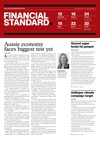Editor's Choice
AGL mulls sale of Tilt Renewables
AGL Energy has confirmed it is considering selling its 20% stake in the wind and solar energy generator.
Nuveen eyes green loans in local RE strategy
Following its first close in December, Nuveen's Australian commercial real estate debt strategy, which has a focus on responsible investing, has received $300 million from the Canadian Pension Plan Investment Board (CPP Investments) on its second close.
Wollemi Capital buys renewables platform
The climate-focused investment firm will pay $19 million for MPower Group's renewable energy and battery storage business after the latter faced challenges in securing funding.
Podcast: Measuring nature assets in portfolios
In this episode of The Greener Way, host Michelle Baltazar discusses the transition to nature-positive investment portfolios with Lucian Peppelenbos, climate and biodiversity strategist at Robeco.



















Imposing a levy on imports that maintains CO@ emissions at local levels MUST include the emissions generated from inbound freight. Then we will some non-sensical product imports.
I imagine it would then kill off the proposal to import potatoes from Canada, for example.
As an employee in the manufacturing sector, I sense that industry is concerned at the downstream cost increases for energy consumption from a tax imposed on producers for CO2 emissions. Our operations in NSW incurred a 30% hike in electricity costs last year.
if a $20 a tonne levy is ever passed through to businesses buying electricity, it will push the cost up another 20%. In marginalising domestic manufacturing, has anyone considered balancing this domestic impost with penalties on energy intensive competitor imports?
Could we not impose an even playing field where importers are required to maintain CO2 emissions at the local level, without going into the territory of protectionism?
I think a lot of the anger being displayed throughout the national electorate is because the impost of a tax implies ONLY that business and consumers will use less fuel & electricity when the cost jumps a further 25%. Where are the pro-active policies for renewables, imports and alternates to balance this community cost?
I understand that electricity userd in NSW will be hit with 42% rises in charges over the next few years due to current infrastructure plans, on top of last year's 30% rise. Now we forsee government layering another 25% based on carbon dioxide emissions.
So the power cost doubles over 3-4 years.
How many businesses in NSW will consequently disappear?
Where is the capacity in substitutes?
Why isn't Paul Howes making a big noise about this?